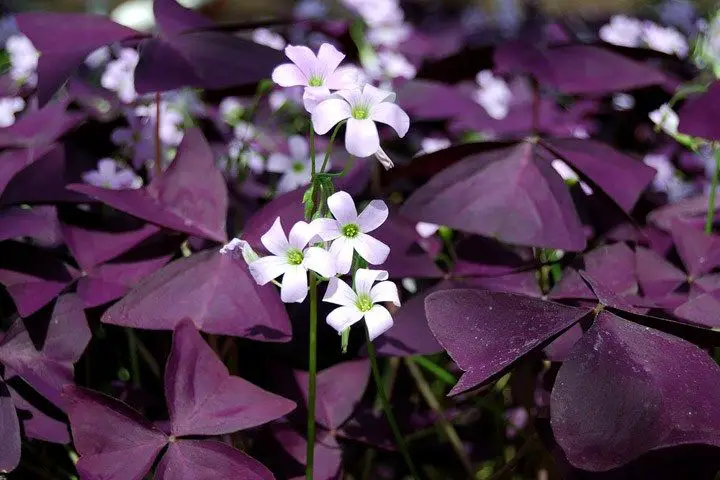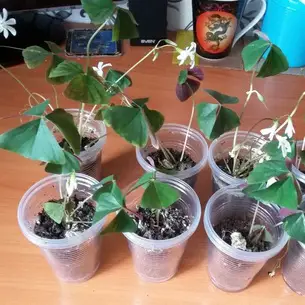Oxalis triangularis takes a worthy place in the collection of florists. This easy-to-care and the unpretentious plant has attractive bright foliage with a bright color. The flowers that form on the bush complement its decorative effect and make it even more attractive.

Even a novice florist can grow this culture, however, before deciding on its cultivation, it is useful to study information about the features of triangular sorrel and its preferences.
oxalis triangularis Violet plant description
| Genus | Kislitsa |
| Family | Acidic |
| Homeland | Africa, Central America |
| Escape type | Creeping |
| Inflorescence | Single |
| Petal color | White, yellow, pink, lilac |
| The structure and color of the leaves | Cirrus or cinquefoil, with three or five lobes, purple, purple, or red |
| Flowering period | March-August |
| Fetus | Seedbox |
| Reproduction | Seeds, daughter bulbs, dividing the tuber |
According to the botanical description, oxalis triangularis is a herbaceous tuberous plant with a height of about 40 – 50 cm. The rhizome is a tuber that forms creeping shoots.
Leaves are compound, pinnately or pinnately arranged, three or five-lobed, most often purple, deep red or purple, attached to short thin petioles. Some varieties have green foliage.
With the onset of darkness, the leaves roll up, in the afternoon they open again.
Flowers oxalis triangularis five-petal, regular shape, can be white, yellow, lilac, lilac, pink. Flowering lasts throughout the spring and summer. In the fall, the plant goes to rest, in a state of which it remains until the end of winter.
At the end of flowering, fruits appear on the bush – miniature boxes with seeds.
The second name of this plant is oxalis triangularis.
oxalis triangularis Care for indoor
Oxalis triangularis is one of the easiest indoor plants to care for. But still, for good health and preservation of the decorative appearance of the flower, certain requirements for location, soil and watering should be observed.
Lighting
When caring for triangular acid at home, it is worth remembering that this plant develops successfully both in bright light and in diffused light. The best place to grow will be windows facing east and south. When placed on sills of a southern orientation, the flower will be exposed to direct scorching rays, which can lead to wilting and drying of the foliage. To prevent this, you will need to create shading at noon.
Air temperature
This crop is not demanding on the air temperature, since it is often grown even in the open field. However, overcooling of the plant should not be allowed, and drafts should be avoided. The optimal temperature range is 18 – 25 degrees. In autumn and winter, when oxalis triangularis is at rest, it is kept in a room with a temperature of 13-15 degrees. It is recommended to keep the flower outdoors in the warm season.
Watering
In summer, violet oxalis triangularis actively grows and develops, so frequent and abundant watering is indispensable. The grower must ensure that moisture does not stagnate in the substrate. Drainage holes, which must be at the pot, will help to avoid an excess of water in the soil. With the onset of autumn, the number of waterings is halved, in winter they are watered only after the earthen coma has completely dried out.
Air humidity
Kislitsa does not need high air humidity and can develop normally in a room with dry air. During long hot periods, it is recommended to refresh the plant by spraying the leaves from a spray bottle with water at room temperature. Use a damp cloth to periodically remove dust from the sheet plates.
Soil mix
A non-capricious plant is suitable for a universal potting soil mixture for indoor plants. Experienced growers make up the substrate themselves. For this, leaf, sod land, sand and peat are mixed. All components are taken in equal parts. It is not recommended to plant a flower in a soil saturated with nutrients, since with a high content of minerals, oxalis actively builds up green mass, which negatively affects flowering. A drainage layer 5 – 7 cm thick must be laid on the bottom of the container. Perlite or expanded clay is used as drainage.
Fertilizer
Indoor oxalis triangularis needs additional fertilizing, which is introduced during the growing season 1 – 2 times a month. Liquid mineral complexes are used to enrich the substrate.
Transplant or repotting
Due to the rapid development of the root system, the transplant of this culture is carried out annually for the first 2 – 3 years. Adult specimens are transplanted after 3 years. This procedure is carried out before the start of the growing season. The dishes should be wide enough, but not too deep for the corms to fit well. The transplant is performed by the transshipment method. The bush is transferred into a new container with an earthen lump, the missing part of the substrate is filled up.
Pruning oxalis triangularis
Triangular oxalis quickly forms new shoots. Timely pruning will help maintain the decorative appearance of the bush. During this procedure, damaged stems, weak shoots are removed. Faded buds are cut off.
Propagation of oxalis triangularis
The triangular sour cherry or oxalis is propagated with the help of seeds, daughter bulbs, and dividing the tuber of an adult plant. The seed method is used less often than the others, but if there is no choice, you can try it.

By seeds
The seeds are evenly distributed over the surface of light, loose nutrient substrate, the container is covered with glass or polyethylene on top and removed to a cool (with a temperature of 15 – 17 degrees), lighted place. During the germination of seeds, the container with crops is opened daily for ventilation, the soil is moistened as it dries. The sprouts should appear in 10 to 25 days.
propagating with bulbs
When propagating with daughter bulbs, the bulbs are separated from the bush, then the planting material is placed in a wide bowl and covered with a small layer of earth. The bulbs are germinated in a semi-shaded place, remembering to moisten the substrate. When the shoots from on the bulbs, they are placed in a lighted place, but away from direct sunlight.
by dividing the tuber
Reproduction by dividing the tuber is carried out after the end of the dormant period. When a new leaf appears on the tuber, the plant is taken out of the pot, the tuber is washed with warm water, kept for 5-10 minutes in a weak solution of manganese, then, using a sharp, clean knife, it is divided into several parts. Denki is seated in separate containers and put away in a lighted place with diffused light.